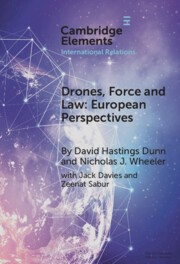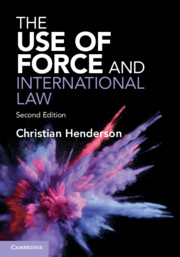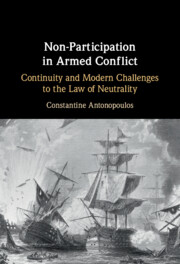38 results
Atomic Force Microscopy Method for Measuring Smectite Coefficients of Friction
-
- Journal:
- Clays and Clay Minerals / Volume 58 / Issue 6 / December 2010
- Published online by Cambridge University Press:
- 01 January 2024, pp. 813-820
-
- Article
- Export citation

Drones, Force and Law
- European Perspectives
-
- Published online:
- 04 December 2023
- Print publication:
- 18 January 2024
-
- Element
- Export citation
1 - The General Breadth and Scope of the Prohibition of the Threat or Use of Force
- from Part I - The Prohibition of the Threat or Use of Force
-
- Book:
- The Use of Force and International Law
- Published online:
- 26 October 2023
- Print publication:
- 09 November 2023, pp 23-88
-
- Chapter
- Export citation
2 - The Meaning of ‘Force’
- from Part I - The Prohibition of the Threat or Use of Force
-
- Book:
- The Use of Force and International Law
- Published online:
- 26 October 2023
- Print publication:
- 09 November 2023, pp 89-132
-
- Chapter
- Export citation

The Use of Force and International Law
-
- Published online:
- 26 October 2023
- Print publication:
- 09 November 2023
-
- Textbook
- Export citation
2 - Torque and Static Equilibrium
-
- Book:
- A Student's Guide to Rotational Motion
- Published online:
- 07 August 2023
- Print publication:
- 03 August 2023, pp 25-53
-
- Chapter
- Export citation
6 - Work and Energy
-
- Book:
- A Student's Guide to Rotational Motion
- Published online:
- 07 August 2023
- Print publication:
- 03 August 2023, pp 110-132
-
- Chapter
- Export citation
1 - Gravity … Attracts!
-
- Book:
- The Irresistible Attraction of Gravity
- Published online:
- 02 March 2023
- Print publication:
- 02 March 2023, pp 4-12
-
- Chapter
-
- You have access
- HTML
- Export citation
7 - Foundations of Royal Authority and Principles of Governance
- from Part II - Texts
-
- Book:
- Medieval Muslim Mirrors for Princes
- Published online:
- 15 January 2023
- Print publication:
- 05 January 2023, pp 180-215
-
- Chapter
- Export citation
8 - The Use of Force by States
-
- Book:
- Fundamental Perspectives on International Law
- Published online:
- 23 November 2022
- Print publication:
- 15 December 2022, pp 442-493
-
- Chapter
- Export citation
30 - Natural Law and Socioeconomic Rights
- from Part V - Rival Interpretations and Interpretive Principles
-
-
- Book:
- The Cambridge Handbook of Natural Law and Human Rights
- Published online:
- 03 November 2022
- Print publication:
- 17 November 2022, pp 448-464
-
- Chapter
- Export citation
Precise Limb Tourniquet Arterial Occlusion Pressure Determination using Real-Time Ultrasonography and a Capacitive-Based Force Sensor
-
- Journal:
- Prehospital and Disaster Medicine / Volume 37 / Issue 6 / December 2022
- Published online by Cambridge University Press:
- 18 October 2022, pp. 772-777
- Print publication:
- December 2022
-
- Article
- Export citation
Randomized Controlled Trial of Group Exercise Intervention for Fall Risk Factors Reduction in Nursing Home Residents
-
- Journal:
- Canadian Journal on Aging / La Revue canadienne du vieillissement / Volume 42 / Issue 2 / June 2023
- Published online by Cambridge University Press:
- 11 August 2022, pp. 328-336
-
- Article
-
- You have access
- Open access
- HTML
- Export citation
4 - Neutrality and the Use of Force
-
- Book:
- Non-Participation in Armed Conflict
- Published online:
- 24 February 2022
- Print publication:
- 03 March 2022, pp 144-174
-
- Chapter
- Export citation

Non-Participation in Armed Conflict
- Continuity and Modern Challenges to the Law of Neutrality
-
- Published online:
- 24 February 2022
- Print publication:
- 03 March 2022
24 - The Vis Viva Controversy
- from Part III - Problems and Controversies
-
-
- Book:
- The Cambridge History of Philosophy of the Scientific Revolution
- Published online:
- 14 January 2022
- Print publication:
- 06 January 2022, pp 439-452
-
- Chapter
- Export citation
Chapter 8 - Sympathy and the Sources of Moral Sentiment
-
-
- Book:
- Hume's <I>An Enquiry Concerning the Principles of Morals</I>
- Published online:
- 08 January 2021
- Print publication:
- 07 January 2021, pp 154-171
-
- Chapter
- Export citation
Chapter Five - Wave–Body Interactions
-
- Book:
- Ocean Waves and Oscillating Systems
- Published online:
- 12 May 2020
- Print publication:
- 28 May 2020, pp 121-203
-
- Chapter
- Export citation
Chapter Six - Oscillating-Body Wave-Energy Converters
-
- Book:
- Ocean Waves and Oscillating Systems
- Published online:
- 12 May 2020
- Print publication:
- 28 May 2020, pp 204-241
-
- Chapter
- Export citation
Simone Weil and the Iliad
- from Key Topics
-
- Book:
- The Cambridge Guide to Homer
- Published online:
- 22 February 2020
- Print publication:
- 05 March 2020, pp 606-608
-
- Chapter
- Export citation



